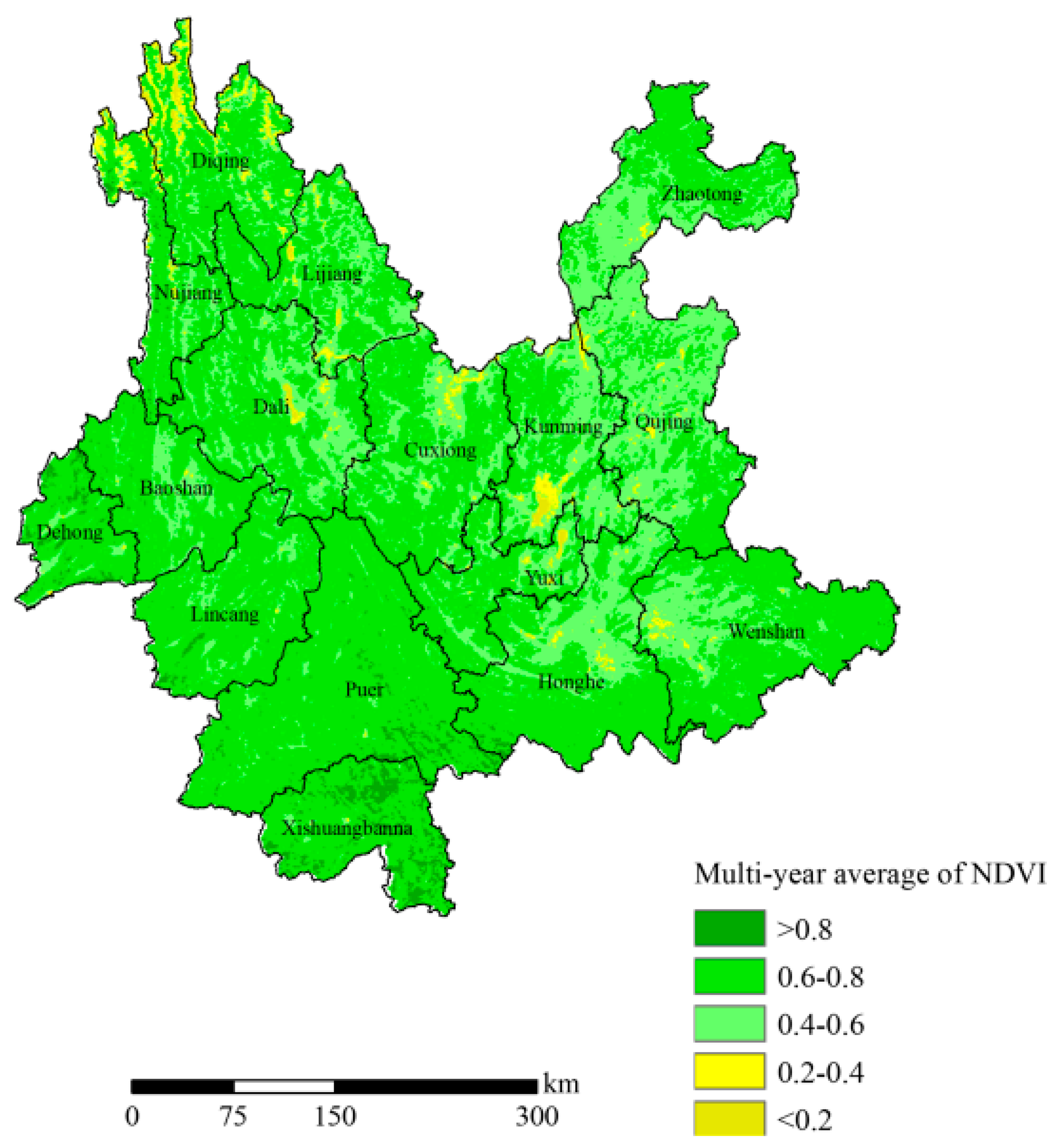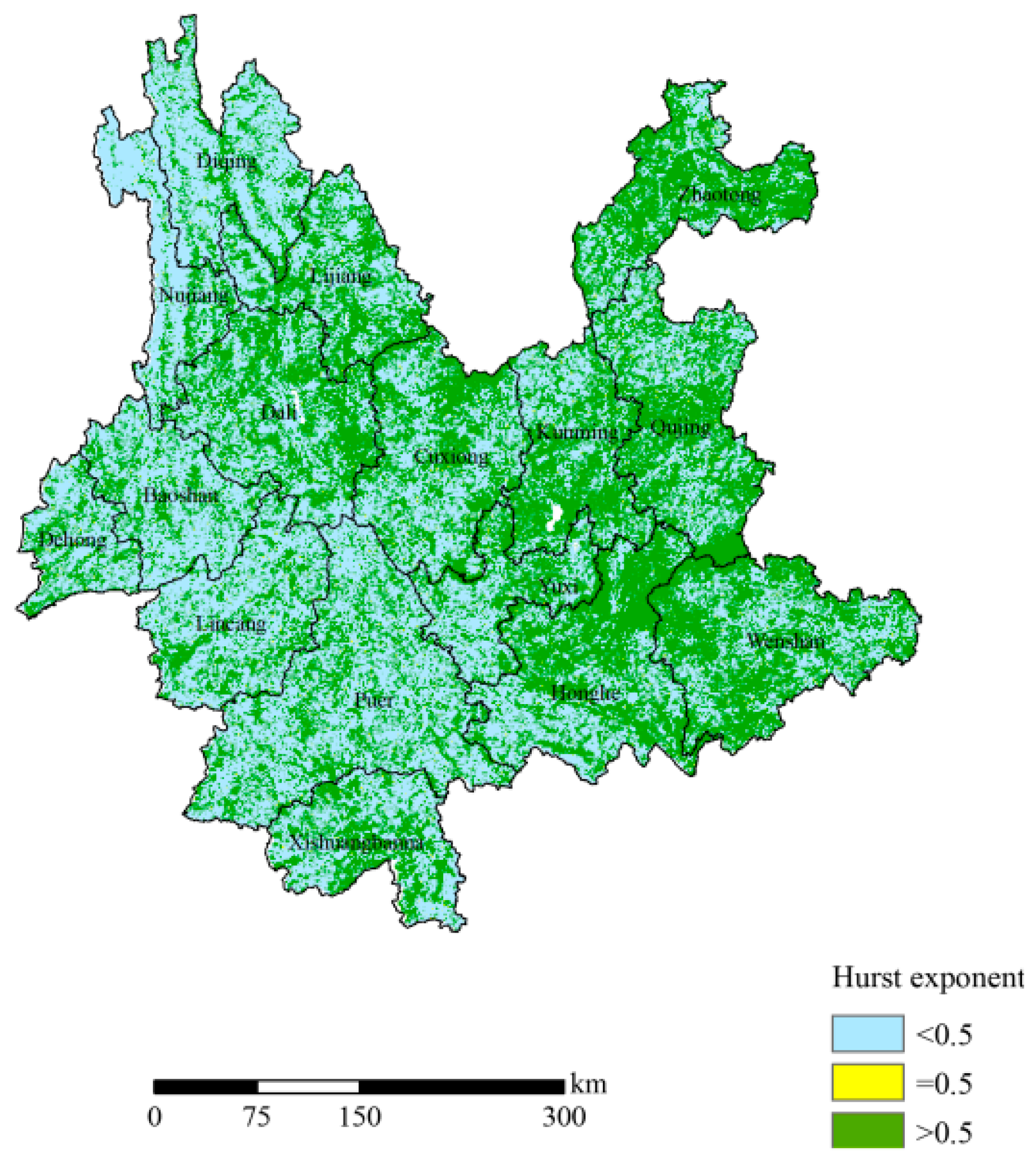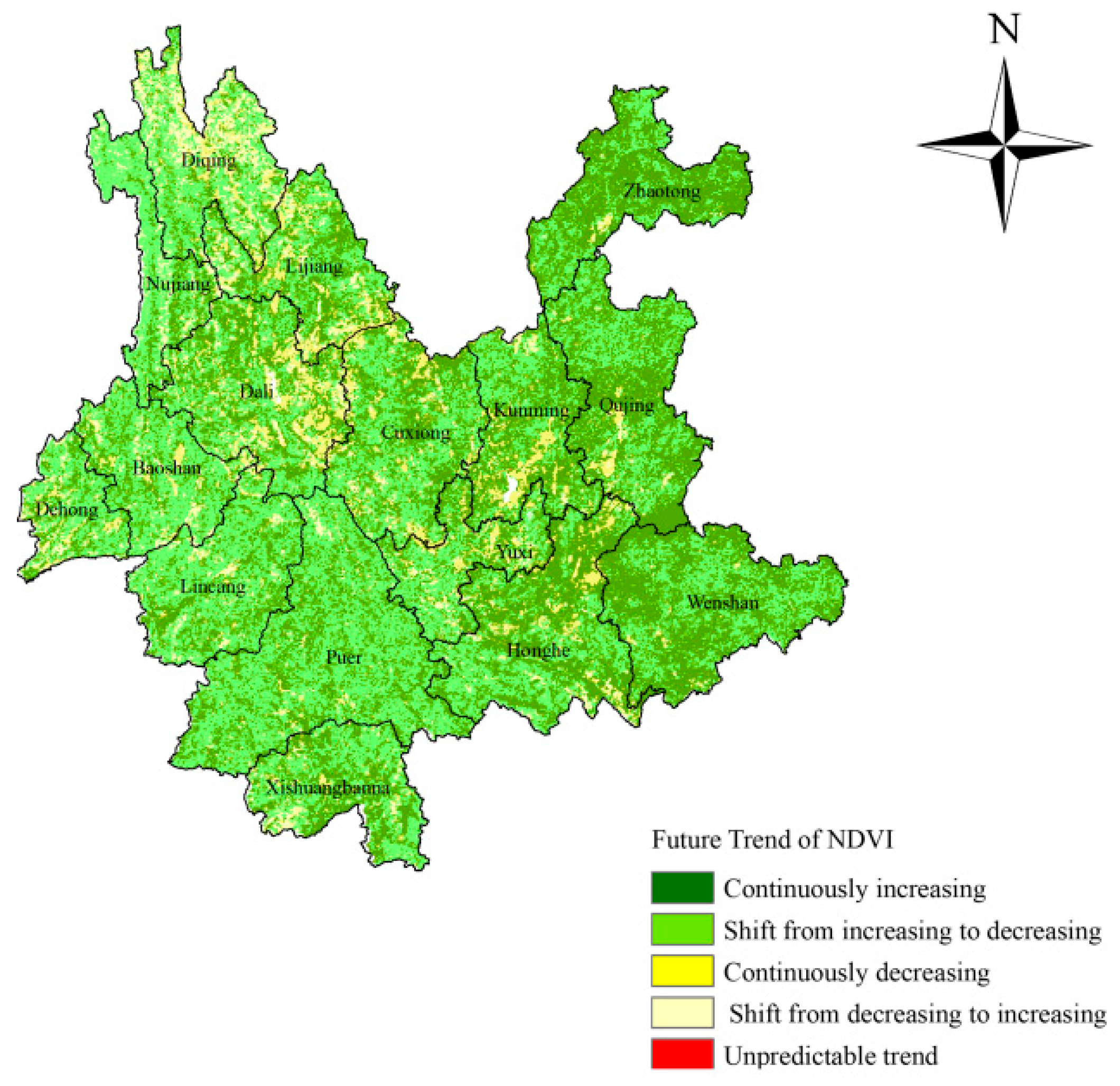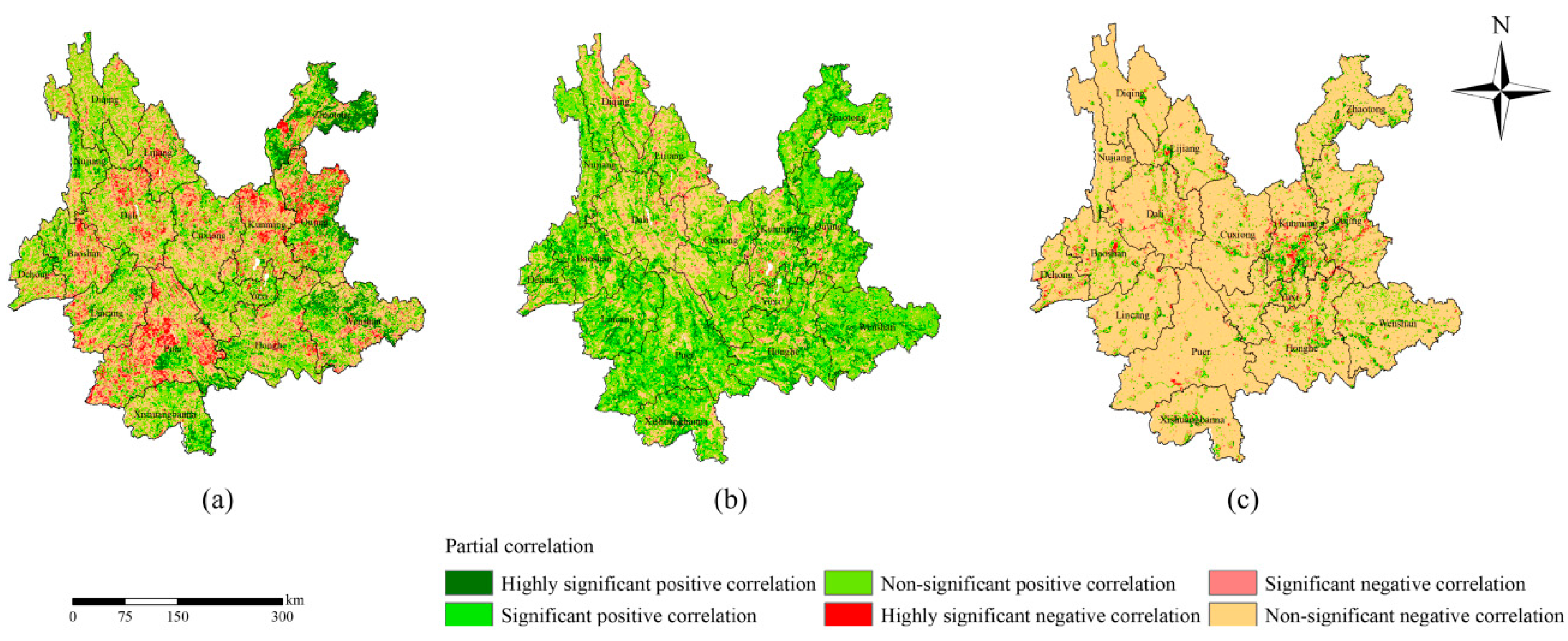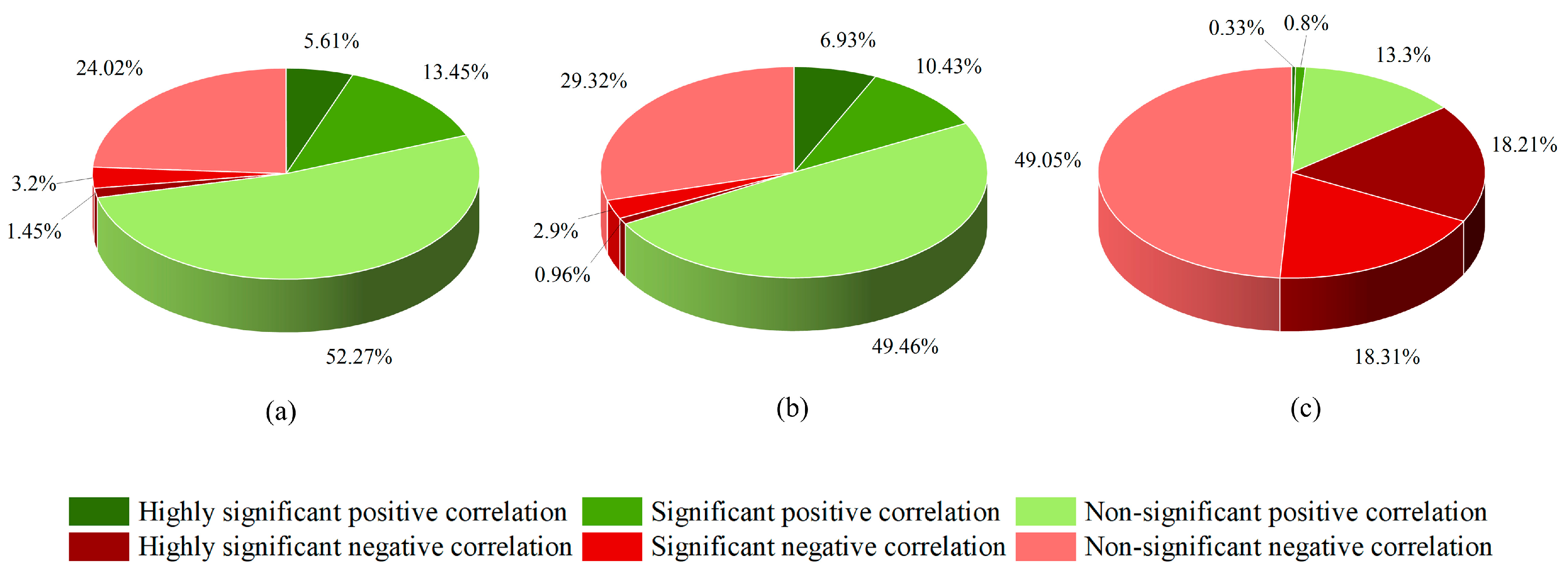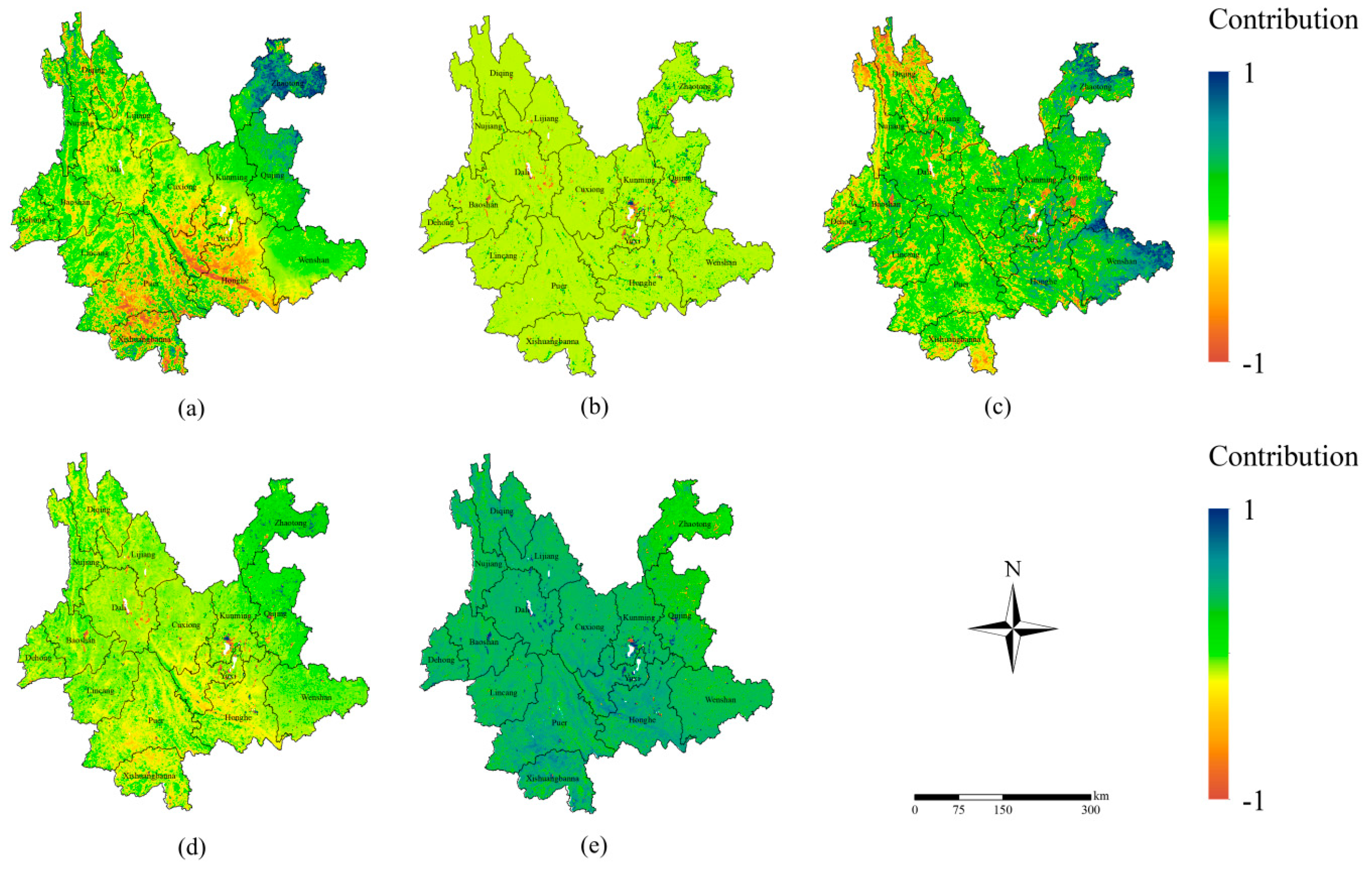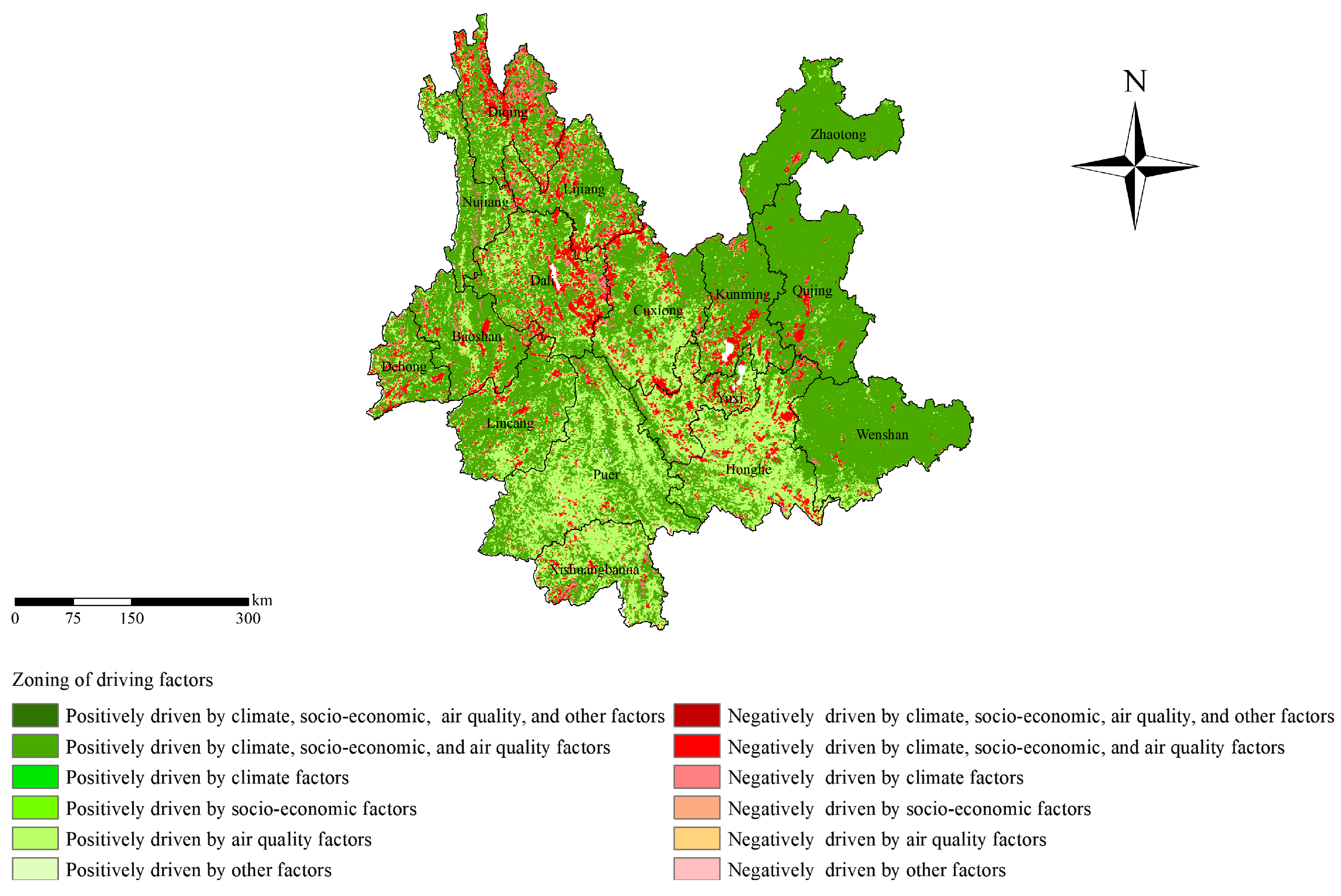1. Introduction
Vegetation greenness refers to the degree of green reflectance from the canopy of surface vegetation. It serves as a key indicator for evaluating vegetation growth status, biomass, and overall ecosystem health. Essentially, it reflects the photosynthetic activity and changes in the leaf area index (LAI) of green vegetation [
1]. The NDVI (Normalized Difference Vegetation Index) is a remote sensing-based vegetation monitoring indicator used to quantitatively assess the growth condition of terrestrial vegetation [
2]. Using the NDVI as an indicator to evaluate the greenness of vegetation can effectively reflect the growth status of vegetation and better carry out ecological protection and management. Situated on the southwestern border of China, Yunnan Province lies at the convergence of the Hengduan Mountains and the Yunnan–Guizhou Plateau. It features complex terrain, diverse climatic conditions, and abundant biological resources, with distinct ecological and geographical characteristics. Yunnan serves as a vital national ecological security barrier and a biodiversity hotspot. It is also a crucial area for climate regulation and water conservation in Southwest China [
3]. At the same time, Yunnan is situated at the intersection of the “Belt and Road Initiative” and the “Western Development Strategy”. In recent years, rapid urban expansion, infrastructure development, and tourism growth have significantly accelerated socioeconomic development, intensifying anthropogenic pressures on the environment. These changes pose challenges to ecosystem stability. Therefore, examining the trends of vegetation greenness in Yunnan and identifying the dominant driving factors of such changes are essential for predicting future ecosystem evolution and enhancing vegetation resilience (
Figure 1).
John et al. [
4] introduced the Normalized Difference Vegetation Index (NDVI) into the public domain, demonstrating its effectiveness in assessing large-scale vegetation growth and cover dynamics, and establishing it as a key indicator of regional ecological quality. Studies on the variation in the NDVI can be traced back to the 1980s, when researchers around the world began using it to characterize ecological changes in vegetation [
5]. In recent decades, numerous scholars have investigated vegetation changes across typical regions globally. For example, Sharma et al. [
6] used MODIS-derived NDVI data to analyze vegetation dynamics in Nepal, revealing a consistent pattern of seasonal greening and browning from 2000 to 2015. Morawitz et al. [
7] monitored the rapidly developing Puget Sound region using the NDVI and found that about 20% of each watershed assessment unit (WAU) showed significant NDVI changes within every five-year period. Eastman et al. [
8] noted a significant upward trend in the seasonal NDVI values across all continents except Oceania.
The driving mechanisms behind the NDVI’s spatiotemporal variation have long been a central research focus. Pang et al. [
9] analyzed the influence of climatic factors on vegetation growth in the Tibetan Plateau and found that the vegetation was highly sensitive to precipitation. Verbyla et al. [
10] used MODIS-NDVI data as a proxy for maximum seasonal photosynthetic activity to explore interannual NDVI patterns (2002–2017) in Alaska and the Yukon, identifying strong correlations with elevation, July temperature, and precipitation. Zoungrana et al. [
11] assessed vegetation degradation in the West African savanna, showing that the NDVI significantly declined when land cover was converted to agriculture and non-vegetated areas due to human activities. Pu Mengxin et al. [
12] applied a geographically weighted regression model to investigate the NDVI dynamics in China’s Giant Panda National Park and found that natural factors, particularly climate and elevation, exerted a synergistic amplifying effect. Li Moyan et al. [
13] analyzed vegetation greening in Xinjiang and discovered that NDVI changes during the growing season were primarily influenced by increased evapotranspiration, especially in grassland and desert ecosystems. Yang Wenjing et al. [
14] identified CO
2 concentration as the dominant driver (average contribution of 45%) of NDVI change in the Haihe River Basin, followed by anthropogenic activities (27%). Nemani et al. [
15] highlighted the spatial heterogeneity of climate’s impact on vegetation, showing that arid northern regions were primarily limited by precipitation, while humid southern regions were more sensitive to temperature regulation. Although numerous studies have examined the effects of climate change, land use, and human activity on vegetation growth, there is a notable lack of research addressing air quality as a key environmental driver of vegetation change. In particular, the mechanisms through which atmospheric aerosols—such as PM
2.5 and PM
10-affect vegetation growth remain understudied. At the regional scale, quantitative assessments of air quality impacts on vegetation still face multiple challenges, including data accessibility, causal attribution, and modeling of spatial heterogeneity. Therefore, further research in this field holds significant theoretical and practical importance.
Although numerous studies have explored the climatic and socioeconomic drivers of the NDVI, the impact mechanisms of air quality factors on the NDVI at the regional scale remain unclear. In particular, for Yunnan Province, an ecologically fragile area, there is still a lack of systematic assessment of the spatiotemporal variation in the NDVI under the combined influence of multiple factors. This study incorporates O3, PM2.5, and PM10 as provincial-scale air pollution indicators to examine their spatial correlation and regional heterogeneity with the NDVI, and further quantifies their actual contributions to NDVI variation, aiming to explore the integrated effects of driving factors on the NDVI when air quality is taken into account. The integration of partial correlation analysis and multivariate residual regression enables a comprehensive assessment of the contribution of various driving factors to NDVI changes and facilitates the spatial delineation of dominant influencing factors. In this context, the present study utilizes NDVI data for Yunnan Province from 2001 to 2020, along with long-term time series data on climate, socioeconomic conditions, and air quality. Through trend analysis and contribution decomposition, we investigated the spatiotemporal evolution of vegetation greenness in Yunnan, quantified the relative contributions of climate, socioeconomic, and air quality factors, and identified the dominant drivers of change. The findings aim to provide scientific evidence for ecological protection and environmental management under ongoing climate and human-induced pressures in Yunnan Province.
4. Discussion
4.1. Spatiotemporal Variations in NDVI
This study explored the spatiotemporal trends of the NDVI in Yunnan Province from 2001 to 2020 and analyzed the driving mechanisms from three perspectives: climate, socioeconomic, and air quality factors.
Temporally, NDVI in Yunnan exhibited a fluctuating upward trend, with an average value of 0.6342, ranging from 0.6063 to 0.6676, and an interannual growth rate of 0.0031. Upon comparison, this is generally consistent with previous studies on the NDVI in Yunnan Province, indicating its reliability [
29]. This suggests a continuous improvement in the region’s greenness level, driven by national ecological programs and localized climatic amelioration. Since 2000, China has implemented several ecological forestry projects, such as reforestation and natural forest protection, effectively improving vegetation conditions in Yunnan, enhancing ecosystem greenness, and promoting regional ecological development. Particularly from 2011 to 2020, under national ecological strategies, vegetation coverage in Yunnan has been increasing steadily [
30].
Spatially, the NDVI in Yunnan showed a distinct pattern of being higher in the south and west, and lower in the north and east, with an overall gradient increasing from northeast to southwest. This pattern is consistent with the province’s vegetation distribution and climatic zones. Yunnan spans multiple climatic subregions, from the highland climate in the northeast to tropical and subtropical zones in the southwest, where dense forest ecosystems dominate. Compared to other vegetation types, forests have more complex structures and deeper root systems, enabling better interception of solar radiation and more efficient use of soil resources, thus enhancing photosynthesis, promoting vegetation growth, and increasing carbon sequestration. In contrast, the northeastern region, with a subtropical semi-arid climate and predominantly grassland use, exhibits lower NDVI. The northwestern area, characterized by high-altitude alpine climates, shows the lowest NDVI due to cold temperatures and limited vegetation, mainly herbaceous plants.
In terms of spatial stability, the southwestern region of Yunnan, with its warm and humid climate, displays lush vegetation and strong ecological stability, with small NDVI fluctuations. The northeast, despite human activity, also shows a relatively stable NDVI. In contrast, the Diqing Tibetan Autonomous Prefecture in the northwest, being ecologically fragile and part of the plateau climate zone, is subject to large NDVI fluctuations likely driven by snowline changes on Meili Snow Mountain. Moreover, the NDVI declines in urban and peri-urban areas such as eastern Dali, southern Kunming, and eastern Yuxi can be attributed to rapid urbanization and industrialization, which replace natural vegetation with built-up land [
31].
Additionally, the Hurst index-based forecast suggests that while NDVI trends are expected to persist in most regions, some ecologically fragile areas—such as alpine zones and hot-dry valleys—face a risk of trend reversal. These areas also showed high coefficient of variation (CV), indicating lower ecosystem stability and underscoring the need for continued ecological protection.
4.2. Analysis of NDVI Driving Factors
From the perspective of driving forces, climate remains the dominant factor influencing NDVI changes. For 20 years, Yunnan has experienced a warming and drying trend. In most areas, precipitation and temperature play a positive role in the NDVI. However, in western and northwestern Yunnan, these correlations are negative. This is due to the region’s steep terrain and predominance of alpine meadows, where excessive rainfall can lead to waterlogging and soil erosion, inhibiting vegetation growth. In the southwest, abundant rainfall can cause overly moist soil and flooding, which also hinder plant growth [
32]. Regarding temperature, the Hengduan Mountains in the west exhibit high elevations and low temperatures that limit plant growth, while the tropical forests in the south may experience growth suppression under excessive heat. The suppressive effect of sunshine duration is evident in regions like Dali, Chuxiong, and Yuxi, where frequent cloudy and rainy weather limits photosynthetically active radiation, thus constraining vegetation growth.
Socioeconomic factors are another important driver of regional NDVI changes, particularly in Yunnan, where ecological diversity coexists with strong development demands [
33]. These factors have dual effects. On one hand, high population density and rapid urbanization lead to land conversion from forest and farmland to urban infrastructure, reducing green coverage and lowering NDVI. On the other hand, in economically developed regions like eastern Yunnan, large-scale ecological restoration projects (e.g., afforestation and grassland recovery) have been effectively implemented, significantly boosting the NDVI. Conversely, in ecologically fragile and less-developed areas such as the northwest, complex terrain and limited economic resources hinder ecological recovery efforts. This implies that a solid economic foundation and proactive ecological governance can mitigate the negative ecological impacts of urbanization.
Air quality factors also influence the NDVI with significant spatial variability and dual characteristics. In high-altitude forested and relatively unpolluted ecological protection zones (e.g., northwestern Yunnan), ozone (O
3) appears to promote NDVI increases. This may be attributed to the stimulatory effects of low-concentration ozone on plant physiological processes, enhancing photosynthesis and antioxidant enzyme activity, thereby improving stress resistance. However, in more industrialized and densely populated central regions, elevated O
3 concentrations exceed vegetation tolerance thresholds, leading to oxidative damage in leaf tissues, suppressed photosynthesis, and a reduced NDVI [
34]. For aerosols (PM
2.5 and PM
10), in areas with good air quality, moderate levels of particulate matter can enhance the NDVI. This is because aerosols scatter sunlight, increasing diffuse radiation that penetrates deeper into plant canopies, thereby improving photosynthesis in shaded leaves. Aerosols can also alter microclimates by reducing vapor pressure deficits and transpiration rates. In cooler climates, aerosol deposition can warm soils by absorbing solar radiation, indirectly supporting plant growth [
35]. Additionally, some aerosol components can enhance soil structure and nutrient content, further benefiting vegetation [
33]. However, under high aerosol concentrations, particles may impede normal plant metabolism, inhibit photosynthesis, and degrade plant health. Harmful components in aerosols may alter soil pH, nutrient availability, and microbial composition, causing toxic effects and disrupting plant physiological processes. Therefore, the impact of air pollutants on the NDVI is not linear but is modulated by pollutant levels, spatial context, and ecological responses. Monitoring and mitigation strategies should thus prioritize pollution-sensitive vegetation regions, supported by both ground observations and remote sensing tools to establish a robust framework for assessing vegetation responses to air pollution.
Other factors, such as pest outbreaks and natural disasters, may also inhibit the NDVI. Although these factors are difficult to quantify directly, they play vital roles in ecosystem dynamics and can significantly affect vegetation greenness.
Despite its widespread use, the NDVI is prone to saturation and may not fully capture canopy or physiological changes. Future studies should integrate other vegetation indices to better assess plant physiological responses. The present study focuses on quantifying the contributions of climate, socioeconomic, and air quality factors to NDVI variation. However, other factors such as land use, natural disasters, and topographic conditions also exert significant influences on the NDVI. Due to limitations in data availability or scale incompatibility, these variables were not included in the model, which may have led to an underestimation or omission of certain driving mechanisms. In addition, deeper spatial heterogeneity has not been fully captured. Even within regions dominated by the same driving factors, the response patterns and sensitivities of the NDVI may vary considerably due to differences in landforms, vegetation types, or management regimes. Therefore, future studies should incorporate methods with stronger spatial and causal inference capabilities—such as geographically weighted regression (GWR) and structural equation modeling (SEM)—to more precisely analyze the driving mechanisms behind NDVI changes.
5. Conclusions
This study quantitatively assessed the spatiotemporal dynamics and driving forces of NDVI in Yunnan Province from 2001 to 2020, integrating climate, socioeconomic, and air quality variables through multiple statistical approaches.
- (1)
The findings revealed a generally increasing NDVI trend, with over 87% of the region showing vegetation improvement, especially in the south and west. Despite this positive trend, areas of potential greenness decline remain, underscoring the need for region-specific monitoring and interventions.
- (2)
Climate variables, particularly temperature and precipitation, alongside GDP and air pollutants such as O3 and PM2.5, were identified as key contributors to NDVI dynamics, jointly explaining a substantial portion of the observed variability. However, the inverse impact of other factors, including land use changes, topographic constraints, and potential data uncertainties, suggests that NDVI evolution is shaped by complex and interacting mechanisms.
- (3)
Notably, 61% of NDVI increases were attributable to the joint effect of the three major factor groups, highlighting the importance of considering compound drivers rather than isolated variables. Still, in declining NDVI zones, the dominant role of unmodeled or local factors suggests limitations in current modeling approaches.
Therefore, it is recommended that Yunnan Province establish an ecological management framework centered on “zonal governance and targeted intervention”. For areas with continuously declining the NDVI or high fluctuation, ecological restoration projects should be prioritized. In regions where high pollution overlaps with ecological sensitivity, the adoption of green and clean energy alternatives should be promoted. At the policy level, the implementation of ecological compensation mechanisms should be advanced to ensure a dynamic balance between ecological protection and regional development.


